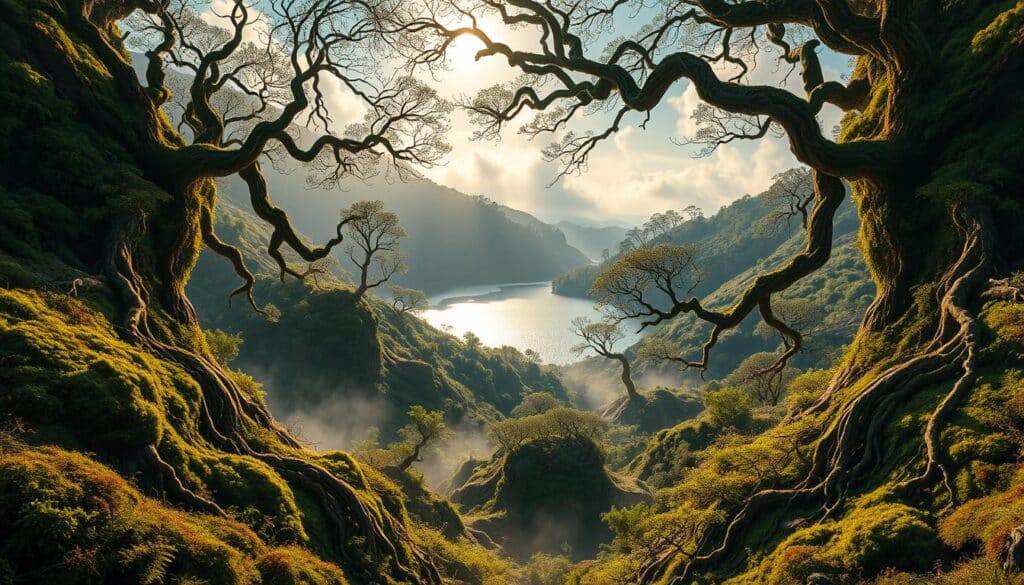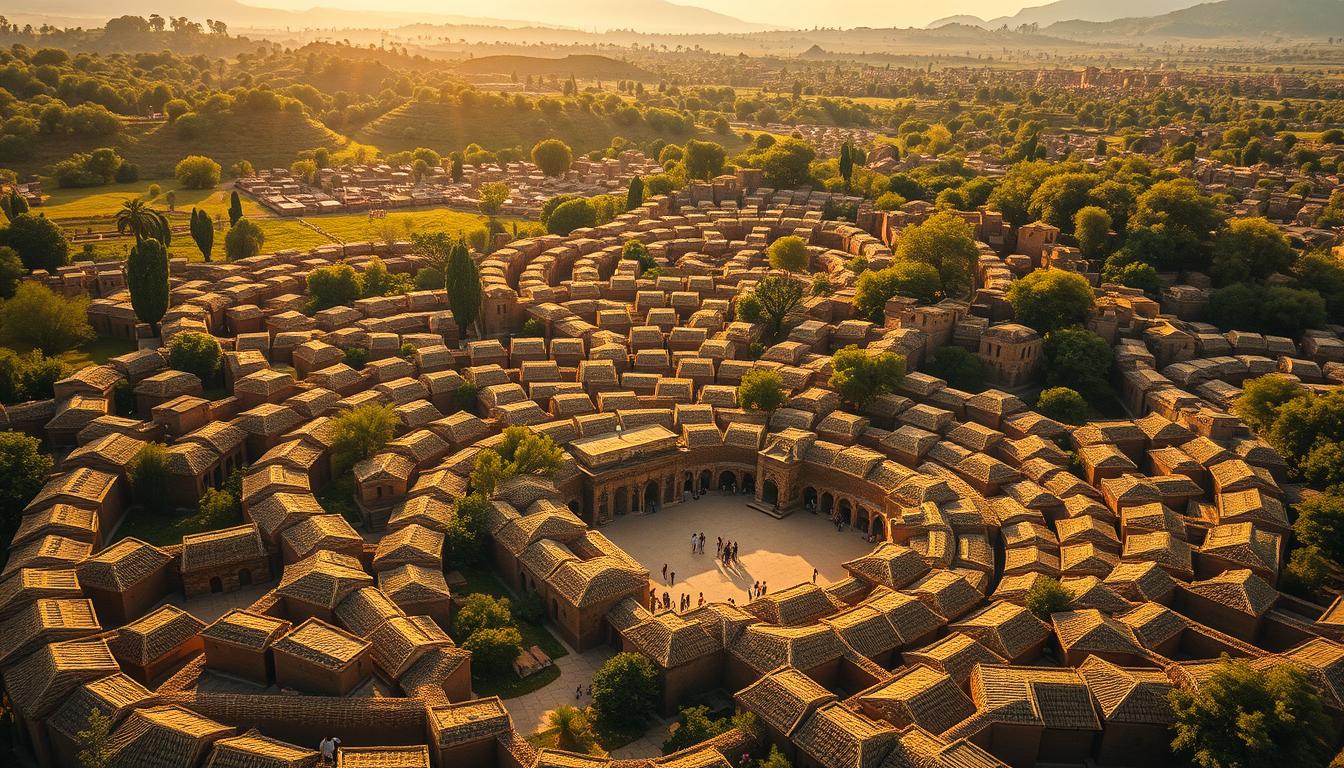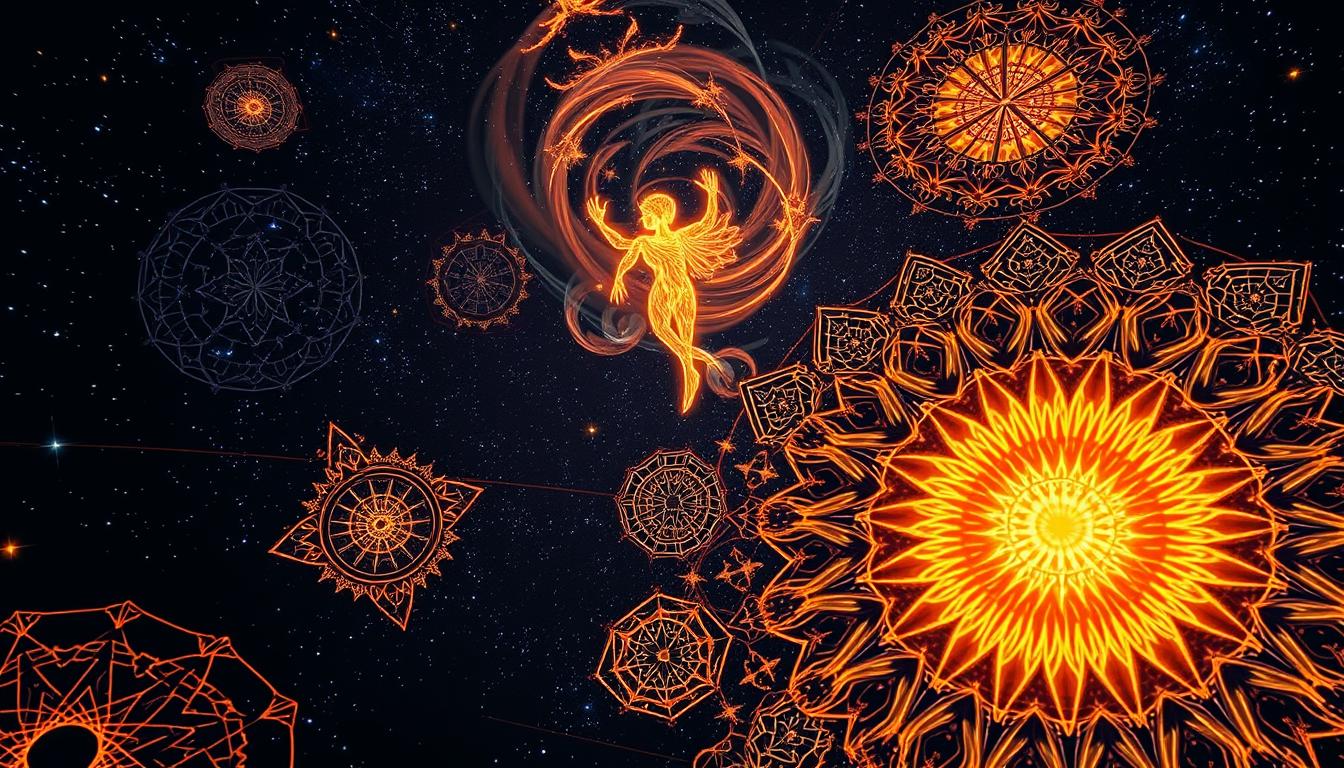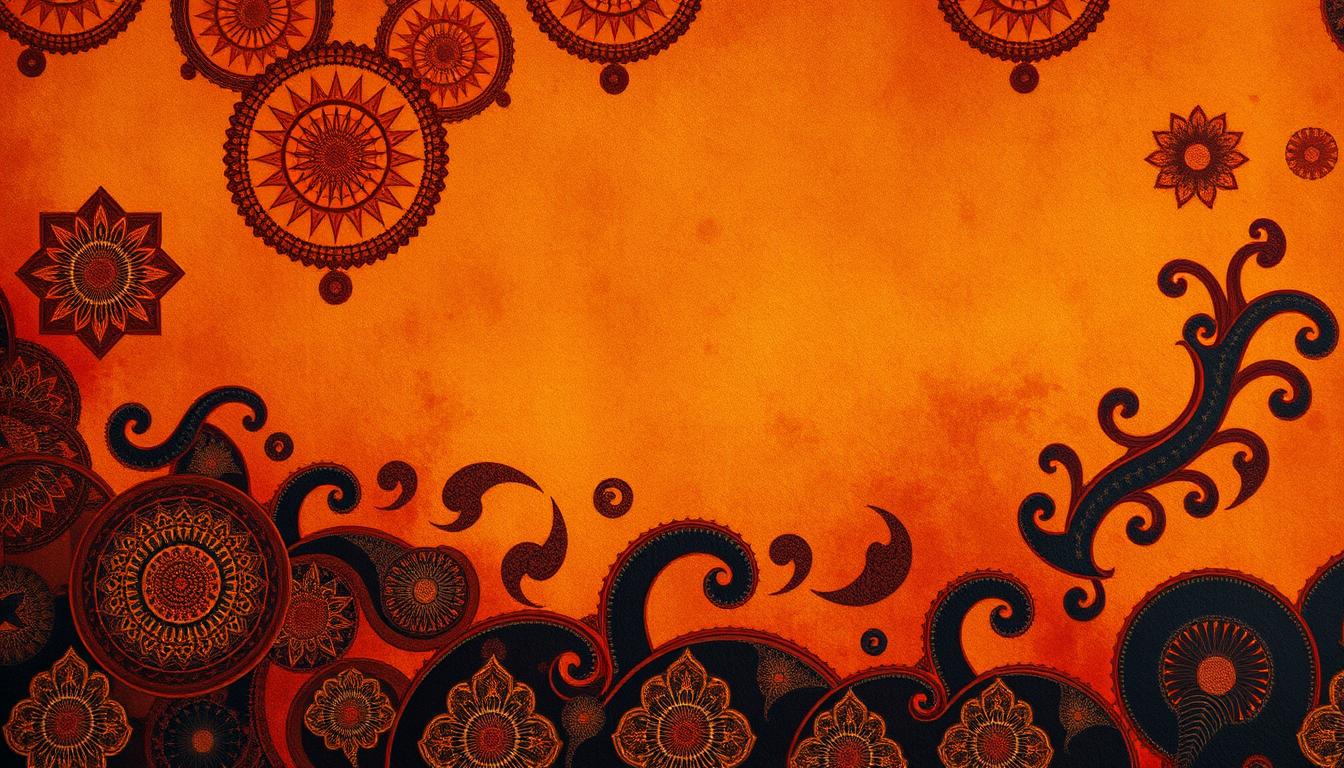Fractal landscapes have intricate patterns that repeat. They let us look deeply into indigenous myths. These patterns show the relationship between cultures, nature, and stories.
The stories tied to these landscapes tell us about the connection to the land, spirituality, and history. We will explore how fractals appear in both the land and tales. This will highlight the rich traditions of indigenous people and how they see the world.
Introduction to Fractal Landscapes
Fractal landscapes mix order and complexity found in nature. They show how chaotic systems can have a consistent structure. This introduction offers a new way to see the environments around us.
Indigenous cultures have a deep connection with their landscapes. They express this bond through stories and symbols. These cultures use fractal concepts to show nature’s rhythms and the bond among all living beings. The math behind fractals connects with the experiences and beliefs of indigenous people. It links art and science.

These landscapes reveal natural beauty and tell stories. They show deep links to identity and spirituality in indigenous cultures. Learning about fractal landscapes helps us appreciate the diversity and complexity of nature and culture.
The Concept of Fractals in Nature
Fractal geometry is a cool way to understand Nature’s complex patterns. It’s different from ordinary shapes because it focuses on patterns that repeat and look alike at different sizes. This idea helps us get why nature looks so intricate, connecting math with what we see around us.
Understanding Fractal Geometry
Studying fractal geometry means looking at shapes that are similar in all sizes. We see this in tree branches and coastlines. It lets us see how small parts of a pattern mirror the whole thing. This gives us a new way to look at and understand nature’s complexity.
Examples of Fractals in Natural Landscapes
Fractals show up in many parts of nature, making landscapes beautifully complex. Some examples are:
- Snowflakes, with their detailed patterns that stay the same no matter their size.
- Coastlines that look alike whether seen from far away or close up.
- Cloud formations that repeat patterns, showing fractal shapes.
These examples show how fractal geometry captures the beauty of nature. It mixes math rules with the beauty we see in the world.
Fractal Landscapes in Indigenous Myths and Legends
Indigenous stories are often linked with the complex beauty of nature’s fractals. These tales highlight self-similar patterns seen in the environment. They use the land as a stage to share their culture. The characters and settings show a close bond, bringing out the richness of storytelling traditions.
The connection between indigenous lore and fractal landscapes is clear in many cultures. Stories about creation, change, and the start of everything reflect nature’s repeating themes. For example, tribes liken mountains, rivers, and forests to their spiritual paths. This shows the importance of nature and the stories told within it.
There are many stories about the cycles of seasons and the movement of animals. These stories remind people of their place in the world, following life’s natural rhythms. Through indigenous tales, these landscapes are more than just backdrops. They become symbols of identity, tradition, and shared memories.
The Cultural Significance of Landscape in Indigenous Narratives
Indigenous cultures hold landscapes very dearly, seeing them as a reflection of their spirituality and ties to nature. These sceneries are more than just backgrounds in tales; they are active participants. They shape the beliefs, practices, and identities of those communities. Nature’s complex patterns often mirror spiritual traditions’ fractal geometry. This highlights how all living things are connected.
Connection to Spirituality and Nature
For many indigenous people, landscapes are sacred and full of wisdom. Their spirituality is deeply connected to the environment, where elements of nature teach important lessons. The way these communities respect the land is shown in their creation tales and daily practices. These emphasize living in harmony and balance with the earth. Such relationships help them understand their role in the life’s bigger picture.
Expressions of Identity and Worldview
Indigenous stories often reflect their unique views of the world through landscapes. These stories include their values, beliefs, and history, shaping their identity. The fractal patterns in nature echo in their art, dance, and language. This shows a viewpoint that humans are a part of a larger ecosystem. Thus, preserving landscapes is crucial, not just as physical places but as keystones of cultural identity and continuity.
Patterns of Self-Similarity in Storytelling
Indigenous stories often mirror nature’s fractal patterns. They weave recursive themes, linking past and future generations. Each tale is a reflection of nature, showing how stories pass down wisdom and teachings.
Recursive Themes in Indigenous Lore
Indigenous stories are filled with recurring themes. They explore life, death, and rebirth, connecting deeply with listeners. Through repetition, these narratives allow people to see reflections of their own lives.
As the stories unfold, they share insights into human experiences and our connection to all life. They remind us that life is a continuous journey.
Visual and Oral Representations of Landscapes
Storytelling vividly brings landscapes to life, showing how nature and culture are intertwined. Indigenous tales often describe specific places, making nature come alive. This relationship between stories and landscapes helps shape identities and memories, deepening respect for our environment.
Ecosystems as Living Fractals
Ecosystems are great examples of living fractals, with complex life patterns. Indigenous cultures see these connections, including them in their wisdom. This deep understanding calls for caring for our environment, aiming for a sustainable future.
Indigenous Knowledge Systems and Environmental Stewardship
Indigenous knowledge values ecosystems, seeing nature as all connected. These beliefs push for caring for the earth, making sure lands stay healthy. By seeing ecosystems as living things, indigenous people help us see nature as a whole. They make sure we leave a good environment for the future.
Fragility and Resilience in Fractal Ecosystems
Ecosystems show us both weakness and strength. Even small changes can make a big difference, keeping biodiversity going. Indigenous methods highlight resilience, helping communities face and overcome obstacles. Understanding this helps us protect natural ecosystems better.
Mathematical Foundations of Fractals in Myths
The link between math and fractals is key to our grasp of complex myths. At the core, self-similarity shows us that big patterns are reflected in the small. This idea is not just in nature. It’s also central in the stories and symbols of indigenous people.
Indigenous myths show a deep view of the world, similar to fractal math. From simple rules, fractals grow — just like these stories grow from basic ideas. They give us deep looks into nature, humans, and what we believe.
Studying the math behind fractals helps us see why these patterns matter in storytelling. The repeating shapes in math and myths let us see how everything is connected. This connection helps indigenous cultures see their place in the world. It mixes math and myth into one big picture of understanding.
The Interplay Between Chaos and Order
The relationship between chaos and order is deep in indigenous myths. It shows the complex nature of the world. Chaos theory reveals how unpredictable elements can create complex patterns. This idea is common in indigenous stories, where chaos leads to understanding and lessons.
Chaos Theory in Understanding Myths
Chaos theory shows systems that look messy but have hidden patterns. Indigenous myths often reflect this concept. They tell stories full of life’s unpredictable moments. For example, natural disasters represent chaos but also teach about resilience and community. Through these stories, chaos is seen as a chance for growth and learning.
Order in the Universe as Reflected in Indigenous Beliefs
Even though chaos exists, indigenous myths highlight the universe’s order. They show how the world follows laws that bring balance and harmony. The lessons in these myths guide behavior. They connect us to nature. This teaches us to respect both chaos and order.
Conclusion
The study of fractal landscapes in native stories shows a deep link between nature, culture, and tales. Fractal patterns are not just to show nature’s beauty. They help us grasp cultural identity and beliefs better. These patterns are part of indigenous myths, reflecting human life’s complexity.
We’ve seen how nature’s self-similarity appears in stories that have been told for generations. These stories form a rich blend of experiences and insights. They echo the universe’s mix of chaos and order. This mix of fractal landscapes and storytelling teaches us about life and our bond with nature.
In the end, understanding fractal landscapes in native stories helps us value cultural and ecological knowledge more. By seeing these connections, we better understand our place in the world. We learn about resilience and harmony from nature’s fractal designs.



